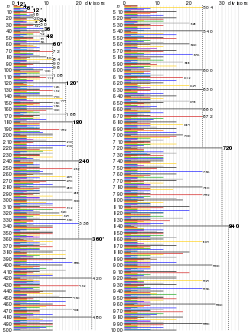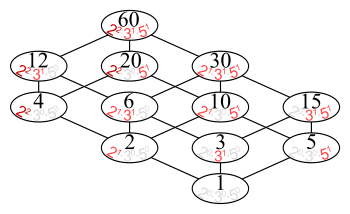Divisor
In mathematics, a divisor of an integer , also called a factor of , is an integer that may be multiplied by some integer to produce . In this case, one also says that is a multiple of An integer is divisible by another integer if is a divisor of ; this implies dividing by leaves no remainder.
Definition
If and are nonzero integers, and more generally, nonzero elements of an integral domain, it is said that divides , is a divisor of or is a multiple of and this is written as
if there exists an integer , or an element of the integral domain, such that .[1]
This definition is sometimes extended to include zero.[2] This does not add much to the theory, as 0 does not divide any other number, and every number divides 0. On the other hand, excluding zero from the definition simplifies many statements. Also, in ring theory, an element a is called a "zero divisor" only if it is nonzero and ab = 0 for a nonzero element b. Thus, there are no zero divisors among the integers (and by definition no zero divisors in an integral domain).
General
Divisors can be negative as well as positive, although sometimes the term is restricted to positive divisors. For example, there are six divisors of 4; they are 1, 2, 4, −1, −2, and −4, but only the positive ones (1, 2, and 4) would usually be mentioned.
1 and −1 divide (are divisors of) every integer. Every integer (and its negation) is a divisor of itself. Integers divisible by 2 are called even, and integers not divisible by 2 are called odd.
1, −1, n and −n are known as the trivial divisors of n. A divisor of n that is not a trivial divisor is known as a non-trivial divisor (or strict divisor[3]). A non-zero integer with at least one non-trivial divisor is known as a composite number, while the units −1 and 1 and prime numbers have no non-trivial divisors.
There are divisibility rules that allow one to recognize certain divisors of a number from the number's digits.
Examples

- 7 is a divisor of 42 because , so we can say . It can also be said that 42 is divisible by 7, 42 is a multiple of 7, 7 divides 42, or 7 is a factor of 42.
- The non-trivial divisors of 6 are 2, −2, 3, −3.
- The positive divisors of 42 are 1, 2, 3, 6, 7, 14, 21, 42.
- The set of all positive divisors of 60, , partially ordered by divisibility, has the Hasse diagram:

Further notions and facts
There are some elementary rules:
- If and , then , i.e. divisibility is a transitive relation.
- If and , then or .
- If and , then holds, as does .[4] However, if and , then does not always hold (e.g. and but 5 does not divide 6).
If , and gcd, then . This is called Euclid's lemma.
If is a prime number and then or .
A positive divisor of which is different from is called a proper divisor or an aliquot part of . A number that does not evenly divide but leaves a remainder is called an aliquant part of .
An integer whose only proper divisor is 1 is called a prime number. Equivalently, a prime number is a positive integer that has exactly two positive factors: 1 and itself.
Any positive divisor of is a product of prime divisors of raised to some power. This is a consequence of the fundamental theorem of arithmetic.
A number is said to be perfect if it equals the sum of its proper divisors, deficient if the sum of its proper divisors is less than , and abundant if this sum exceeds .
The total number of positive divisors of is a multiplicative function , meaning that when two numbers and are relatively prime, then . For instance, ; the eight divisors of 42 are 1, 2, 3, 6, 7, 14, 21 and 42. However, the number of positive divisors is not a totally multiplicative function: if the two numbers and share a common divisor, then it might not be true that . The sum of the positive divisors of is another multiplicative function (e.g. ). Both of these functions are examples of divisor functions.
If the prime factorization of is given by
then the number of positive divisors of is
and each of the divisors has the form
where for each
For every natural , .
Also,[5]
where is Euler–Mascheroni constant. One interpretation of this result is that a randomly chosen positive integer n has an average number of divisors of about . However, this is a result from the contributions of numbers with "abnormally many" divisors.
In abstract algebra
In definitions that include 0, the relation of divisibility turns the set of non-negative integers into a partially ordered set: a complete distributive lattice. The largest element of this lattice is 0 and the smallest is 1. The meet operation ∧ is given by the greatest common divisor and the join operation ∨ by the least common multiple. This lattice is isomorphic to the dual of the lattice of subgroups of the infinite cyclic group .
See also
- Arithmetic functions
- Divisibility rule
- Divisor function
- Euclid's algorithm
- Fraction (mathematics)
- Table of divisors — A table of prime and non-prime divisors for 1–1000
- Table of prime factors — A table of prime factors for 1–1000
- Unitary divisor
Notes
- for instance, Sims 1984, p. 42 or Durbin 1992, p. 61
- Herstein 1986, p. 26
- FoCaLiZe and Dedukti to the Rescue for Proof Interoperability by Raphael Cauderlier and Catherine Dubois
- . Similarly,
- Hardy, G. H.; Wright, E. M. (April 17, 1980). An Introduction to the Theory of Numbers. Oxford University Press. p. 264. ISBN 0-19-853171-0.
References
- Durbin, John R. (1992). Modern Algebra: An Introduction (3rd ed.). New York: Wiley. ISBN 0-471-51001-7.CS1 maint: ref=harv (link)
- Richard K. Guy, Unsolved Problems in Number Theory (3rd ed), Springer Verlag, 2004 ISBN 0-387-20860-7; section B.
- Herstein, I. N. (1986), Abstract Algebra, New York: Macmillan Publishing Company, ISBN 0-02-353820-1
- Øystein Ore, Number Theory and its History, McGraw–Hill, NY, 1944 (and Dover reprints).
- Sims, Charles C. (1984), Abstract Algebra: A Computational Approach, New York: John Wiley & Sons, ISBN 0-471-09846-9
